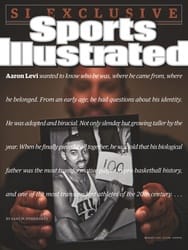
KNIGHT TRUMPS WIZARD
"The team that makes the most mistakes will probably win."
—WARD (PIGGY) LAMBERT
Purdue coach (1916--17, '18--19 through '45--46)
"Victory favors the team making the fewest mistakes."
—BOB KNIGHT
Indiana coach (1971--72 through 1999--2000)
THE GRIND IS REAL. College basketball, in 2014--15, is being played at the slowest pace in the recorded history of the sport. Yet no consensus exists as to why tempo has been on a general decline since the mid-1970s and why the implementation of 45- and 35-second shot clocks failed to stop it. This is my attempt at a Unified Theory of How Things Got So Damn Slow. It's based on the premises that coaches dictate style and that, among coaches, there have been a few great influencers and a great many followers.
A logical place to start: the fall of 1975. The season before, John Wooden won his 10th title at UCLA and the average tempo was near its alltime peak, at 82.7 possessions per game. (It's 64.9 now.) Wooden's retirement marked the end of a dynasty and the beginning of the sport's riding its brakes. In the 1930s, Wooden had been a point guard at Purdue under Lambert, who believed in the creative freedom of fast-break basketball and viewed mistakes as an acceptable cost of letting his players thrive in the speed game. With the Bruins, Wooden was an offense-first coach who prioritized the fast break over all else—and did so because it was pleasing to watch. "It is my feeling that the fans prefer and deserve to see as much action as is compatible with good play," Wooden wrote in his book Practical Modern Basketball, adding that he felt the need to be especially exciting in a town where he was in competition with the weather. "The ball control and stalling type of game can be excellent basketball, perhaps the very best, but I am convinced that the game would gradually, but surely, lose its popularity if all teams used that style of play."
That advice, despite coming from the Great Dispenser of Hoop Wisdom, was largely tuned out. Wooden's philosophy of micromanaging skill development and preparation (down to the snugness of his players' socks) while being laissez-faire during games was empowering, and former Bruins star Bill Walton has described the way UCLA flowed on offense as being "like a dance." But Wooden's blueprint wasn't easily replicated. For the dance to be balletic, great talent was required, and no coach was going to be able to recruit the way Wooden did during his reign. For the have-lesses and the have-nots, it was practical to go in the opposite direction.
There is obvious symbolism in UCLA's first game after Wooden retired: a 20-point loss to Indiana and Knight on Nov. 29, 1975—the opener of the last undefeated season in men's college basketball history. The Hoosiers' pressure man-to-man defense was so physical that a Bruins assistant scouting them during their preseason games lamented, "They've got five guys fouling at the same time, and it's hard for the officials to pick out one man." While Knight let his most talented IU teams run, his overarching philosophy was one of control: of using defensive aggression to take away opponents' preferred options; of taking help D to a new level by teaching that the top priority for all five players was stopping the ball; of mandating a deliberate hunt for shots he wanted on offense, because as he wrote in a book co-written with mentor Pete Newell, "We don't have any trust in the young player's ability to determine shot selection."
Knight had signs in his locker room that said MOVEMENT + PATIENCE = BASKETS AND VICTORY FAVORS THE TEAM THAT MAKES THE FEWEST MISTAKES. And in his second season in Bloomington, when he saw a sign at a team banquet that said GOOD LUCK TO COACH KNIGHT AND THE HURRYIN' HOOSIERS—the nickname IU had in its days under Branch McCracken, who was like Lambert a fast-break-and-mistake enthusiast—Knight said of whoever wrote it, "That guy's got to be the most optimistic man in Indiana."
West Point was where Knight had established himself as the country's preeminent defensive grinder, from 1965--66 to '70--71. He molded low-talent Army teams into improbable winners; the bard Al McGuire described those teams as being "like a little dog that grabs hold of your leg and won't let go." When Knight took Army to the NIT Final Four in '70, Pete Maravich and LSU were in the other semifinal; the most prolific scorer in the game's history was a senior, on his way out, and the most important defensive coach in the game's history was beginning his rise. That the major decline in the sport's tempo coincided with the period during which Knight was the face of coaching—the '70s and '80s—was not a coincidence. His blueprint of pressure, help and mistake avoidance was initially devised for an extreme underdog, and thus was transferable to programs at every level.
And while Knight had issues—with his temper, with his language, with four-legged plastic projectiles—selfishness with his concepts was not one of them. He was the most sought-after clinic speaker of that era, and in conjunction with his lectures, he sold pamphlets entitled Let's Play Defense, with an illustration of a devil (horns, tail, claws, steam spewing from nostrils) in a defensive stance on the cover. The 37-page booklet diagrammed Knight's man-to-man D, as well as the drills necessary to implement it. One of the few photos inside was of a young Mike Krzyzewski in an Army practice uniform, demonstrating proper technique. Coach K has won 1,009 games (and counting) and become the next face of college coaching. Among the hundreds (and possibly thousands) of coaches who became converts after throwing down a buck or two for Let's Play Defense were Philadelphia University's Herb Magee, the other coach who surpassed the 1,000-win mark this season; Steve Fisher, whose San Diego State team ranks third in defensive efficiency (and 317th in tempo); and a Wisconsin high school coach named Dick Bennett, who made it his mission to attend every possible Knight clinic.
Bennett's eventual success at D-III Wisconsin--Stevens Point was built on Knight's pressure principles. And when Bennett developed his own signature D—the Pack-Line—to win with an underdog at Wisconsin--Green Bay in the mid-'90s, he took Knight's idea of early help to the extreme, packing in to stop penetration, prioritizing containment over steals and sacrificing offensive rebounding in favor of preventing transition buckets. Bennett then took Wisconsin to the Final Four in 2000 using that scheme, and passed it on to his son, Tony, whose 27--1 Virginia team is ranked No. 2 nationally in defensive efficiency—and 348th in tempo, at 60.2 possessions per game. Meanwhile the team which has been ranked either No. 1 or 2 in offensive efficiency for most of the season, Wisconsin, is 344th in tempo and thriving because it does not make mistakes: Bo Ryan's Badgers are so careful with the ball that they turn it over on just 12.2% of possessions, the lowest rate in the country. Calculating basketball, in 2014--15, is winning basketball. The heightened understanding of efficiency, combined with the increased video tools available to scout opponents, has teams locked in nightly chess matches—the antithesis of the fast action that Wooden believed was essential to the health of the game.
VIRGINIA IS currently allowing 50.1 points per game, which is close to the modern record of 47.2, set in 1981--82 by Fresno State. The Bulldogs' coach at the time, Boyd Grant, used a style he called "tempo programming." Ron Adams, a young assistant who was in charge of the D, says the genius of Grant "was that he wasn't concerned about beating the teams we should beat; he was concerned about how we were going to beat the teams better than us—and so we taught a very technical brand of defense." The Bulldogs alternated between pressure man and a confusing matchup zone that took a team that was a perennial D-I cellar-dweller when Grant arrived in '77 to the NIT championship in '83.
Bennett would borrow Fresno's method of closing out—hands high, weight back—for his Pack-Line, but there were plenty of detractors. UC Irvine coach Bill Mulligan nicknamed the Bulldogs' style Vomit Basketball, and UCLA refused to schedule them for fear of alienating fans. Some coaches still believed that great defense and a fast tempo did not have to be mutually exclusive. The blueprint for this style, in 2014--15, is the Golden State Warriors, who lead the NBA in defensive efficiency and possessions per game—the first team in the league's modern era to do so. The architect of the Warriors' defense is none other than Adams, who had a short stint as Fresno's coach in the mid-'80s but found his calling as a defensive-guru assistant in the NBA, where, he says, there is a "different, time-tested language and rhythm to offense and defense than in the college game." He adapted, and now he presides over (one end) of the most exciting, freewheeling show on hardwood. This should give hope to us all: There can be life after Vomit Basketball.
McGuire described Knight's teams as being "like a little dog that grabs hold of your leg and won't let go."
Teams are locked in nightly chess matches—the antithesis of the fast action Wooden believed was essential.
PHOTO ILLUSTRATION
Illustration by Ian Keltie
RICH CLARKSON/NCAA PHOTOS (WOODEN, THOMAS); RICH CLARKSON FOR SPORTS ILLUSTRATED (KNIGHT, WILKERSON); FOCUS ON SPORT/GETTY IMAGES (ALCINDOR)
CLASH OF TITANS The free-flowing style Wooden ran with Lew Alcindor (top left) stands in stark contrast to the scripted offenses Knight gave to Isiah Thomas (11) and Bob Wilkerson (20).
PHOTO
RICH CLARKSON FOR SPORTS ILLUSTRATED (KNIGHT)
DEVIL IN THE DETAILS Knight gave scores of clinics on his defensive philosophy, and devotees snapped up his step-by-step guide for replicating Indiana's success.
PHOTO
SCHOOL OF PUBLIC HEALTH LIBRARY AT INDIANA UNIVERSITY (PAMPHLET)
[See caption above]
PHOTO
CHRIS KEANE FOR SPORTS ILLUSTRATED (KRZYZEWSKI)
EARLY ADOPTERS Krzyzewski (top left), Magee (bottom left) and Fisher (bottom right) learned from Knight, while Virginia's Bennett has improved on the scheme his father ran.
PHOTO
GERRY BROOME/AP (BENNETT)
[See caption above]
PHOTO
STEVE DYKES/GETTY IMAGES (FISHER)
[See caption above]
PHOTO
DREW HALLOWELL/GETTY IMAGES (MAGEE)
[See caption above]

